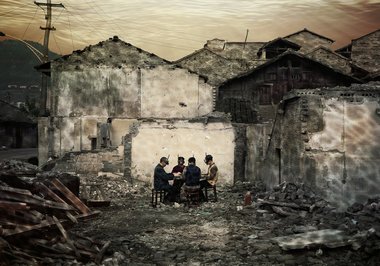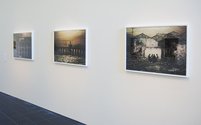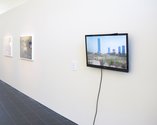Peter Dornauf – 12 July, 2012
These ‘dissidents' bear witness to the violent upheaval that accelerated social and physical change brings, imposed as it is on populations that have little power or say in matters directly affecting their lives, traditions and culture. The irony here is that the Communist state, with its long held antipathy toward the West, are now at pains to ape the West in its rush to be industrialized, urbanized and globalized.
Hamilton
International group show
Raised Voices
Curated by Karl Chitham
2 July - 10 August
Not too far from a place near you the machinations of the totalitarian state work out their elephantine and utopian plans with scant regard to the individual or local communities whether large or small. Karl Chitam’s recent visit to East Asia gave him front seat viewing of such destructive phenomena which he describes as “the rapid move toward the western model of consumerism” in his essay accompanying the current show on at the Calder and Lawson Gallery, Waikato University. It displays the work of local artists he returned with, Chinese and South Korean practitioners who have mounted a photographic protest which Chitham has entitled Raised Voices.
These ‘dissidents’ bear witness to the violent upheaval that accelerated social and physical change brings, imposed as it is on populations that have little power or say in matters directly affecting their lives, traditions and culture. The irony here is that the Communist state, with its long held antipathy toward the West, are now at pains to ape the West in its rush to be industrialized, urbanized and globalized.
The most graphic example of this disjunction is seen in the work of Yang Yi. His surreal choreographed photograph of people sitting at a table in a domestic configuration amid the ruins of empty buildings, each of them wearing snorkels, is an arresting image. The back story to these constructed pictures is the fact of recent flooding of an entire town by the Yangtze River in order to complete the Three Gorge Dam, the world’s largest Hydro power project. The artist describes how in 2008, fifty thousand residents lined the banks of the river to witness the flooding of their two thousand year old city, watching with tears in their eyes as the waters obliterated their homes, their history and heritage. Shades of Cromwell in the South Island, albeit on a much larger scale. The series, entitled Uprooted, could be emblematic of the twentieth century itself, displacement being one of the defining characteristics of the age, whether a product of war or ruthless technological advance at the expense of traditional communities.
Yi’s critical images would no doubt be seen by the state as subversive, counterproductive to the vision of the glorious revolution, so it’s small wonder he is no longer a resident either of Kaixian (the flooded city) or China itself. These photographs give witness to ideological even pathological states of mind on behalf of dictatorial powers willing to subsume all in the name of aggrandizement on a monstrous scale. Here we see in these composite photographs the triumph of materialism deconstructed in a most telling way.
Kerry Ann Lee, of Chinese descent but resident in New Zealand, recently returned from a working visit to Shangai, a place that has become through rapid development, a megacity of twenty million people, larger than Beijing itself. Her photomontage of futuristic, utopian images mock that whole Expo hype associated with fantasized projections of the technocratic future - all atomic globes and gleaming dream ladders that had its origins back in the nineteen fifties, aka world fairs, Festivals of Britain etc, sprouting space modular patterns, embodying the optimistic, post-war brave new world zeitgeist, shiny as a new rotisserie, smooth as a Scandinavian Electrolux. The Lilliput title taps into the social and political critique of Swift’s Gulliver’s Travels. Though clever and satirical, we have however seen this photo-shopped stuff before on a similar theme.
She also produced a series of videos, a real-time documentary of the artist en route via bus, boat and train across the city that captures the frenetic energy of the sprawling megalopolis. So rapid is the physical change in this conglomeration of high-rises that Chitham notes that many of the places featured on the film now no longer exist.
The third contributor to this small suite of art activists is a South Korean pop group calling itself The Michelangelo Pistoletto Band. With such a post punk redolent name, one would expect a certain amount of anarchistic piss-take associated with their music and videos. Using electro-pop love songs and bizarre costumes, the link with the Cabaret Voltaire comes to mind as this duo turns their attention to the repercussions of urban development in a city that boasts the world’s tallest twin tower; a world where bigger, more lavish and expensive become markers for economic success.
The final member of this quartet of artists is New Zealander, Eve Armstrong. EyeContact readers will be familiar with her recycling theme, using among other things, sheaves of cardboard boxes to create topographical compositions. Hers is a concern with capitalist waste, the stuff left over from modern consumer consumption. It thus fits with the compulsive destructive trope explored by the others in this show. Knock On, 2008, is a landscape or more properly a wastescape that ingeniously uses brown packing tape to convincingly create a faux earth and sky scene complete with a heterogeneous collection of objects stuck onto the setting which themselves come from discarded photographs. The whole thing is mounted on metal shelves to complete the salvage and reuse motif.
In The Doomsday Handbook by Alok Jha, there are outlined fifty ways the world could end. He explores the usual candidates from ozone depletion to asteroid impact, but it was the chapter ‘Death by Euphoria’ that caught my attention in the context of this exhibition. Human overreach fuelled by mad dreams seems to be at the core of much of our ruin both physically and spiritually. The voices raised in this exhibition belong to a long line of dissent that reaches back to Fritz Lang’s Metropolis. That these voices are still required is not only troubling but also fundamentally depressing.
Peter Dornauf






 Two Rooms presents a program of residencies and projects
Two Rooms presents a program of residencies and projects Advertising in this column
Advertising in this column



This Discussion has 1 comment.
Comment
Owen Pratt, 7:03 p.m. 12 July, 2012 #
http://www.youtube.com/watch?v=ksZjZw2BeG0
Participate
Register to Participate.
Sign in
Sign in to an existing account.